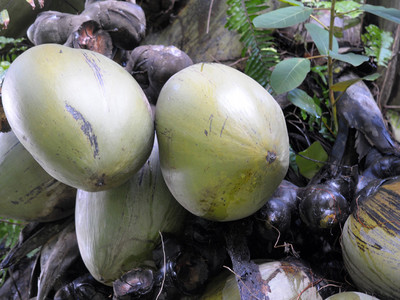Island Hopping through the Seychelles
7th to 19th of December 2017
Mahe to Dar es Salaam aboard the MS Serenissima
Thursday, 7th December 2017 - Port Victoria, Mahe, Seychelles
After a long flight from London and the English winter we finally arrived at the small airport of Mahe on the Seychelles. Our plane lands just after 3 pm and we are greeted by high humidity and temperatures, which clearly tell us that we have arrived in the tropics. Immigration and customs procedures only take a few minutes and our luggage is delivered quickly to one of the two carousels. The local agents and two members of the expedition team guide us to the waiting minibuses and 15 minutes later we arrive at our home for the next 12 days, the Serenissima. At 5:30 pm the chief officer Boris takes us through the mandatory lifeboat drill and at 6:30 pm our expedition leader Jean-Pierre welcomes us on board and we meet the members of the expedition team. The assistant expedition leader Andrea gives us an overview of the ship and David introduces us to the zodiacs, which will be our main means of transportation for the next 12 days. Then it is time for dinner and early bedtime, because we will have a big day tomorrow.
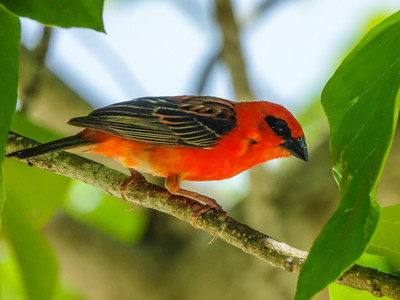
Friday, 8th December 2017 - Praslin & La Digue, Seychelles
Today we are planning to visit two islands of the inner Seychelles, Praslin and La Digue. At 8:30 am our first Zodiacs go ashore and from the jetty we hop onto minibuses, which take us directly to our first destination, the famous "Vallée de Mai". This world heritage site is unique in the world and hosts a large natural stand of the endemic "Coco de Mer", a species of palm tree with the largest seed in the world. The palm with its fanshaped leaves grows to a height of 25-34 m and carries large double nuts, which weigh on average around 23 kg. Although the largest nut ever weighed reached 42 kg! This unique forest of ancient Gondwana plants is also home for 5 other endemic palm species and a variety of endemic birds, mammals, reptiles and invertebrates. On our short walk today we are lucky to spot the elusive Seychelles black parrot and the giant bronze gecko, which has an important role in pollinating the palm trees. From the "Vallée de Mai" our bus takes us to the "Cote d' Or", a long beach on the other side of the island and main tourist hub. We enjoy the refreshments and some of us take the chance for a quick dip in the ocean. Others just explore the vegetation along the beach. Here we find nets of giant female palm spiders with their tiny males at the back of their net. Making love as a male palm spider is a dangerous job. Only too often the males end up on the dinner menu. While we are having our refreshments the ubiquitous bright red Madagascar fodys hop around our feet waiting for morsels to fall down. Just before noon we are all back on board and enjoy our lunch. No time for an after lunch nap today! At 2 pm we take to the Zodiacs again to land on the neighbouring island of La Digue. Open trucks take us to l'Union estate, a plantation, which still produces copra, vanilla and some fruits and also hosts a number of giant Aldabra tortoises. The estate is adjacent to the famous beach of "Source d' Argent", where we can enjoy some free time before we head back to the landing site in the small village of La Passe. Even on the plantation we are able to spot some spectacular wildlife. The chick of a white-tailed tropicbird sits in a tree hollow right next to the plantation house, an endemic Seychelles kestrel (Falco araea) with his lunch menu of fresh rat quietly sits on a wire and bright green day geckos (Phelsuma sp.) inhabit the plantation house. Impressive granite formations line the beach of "Source d' Argent" and herons and wading birds take advantage of the low tide. We identify a grey heron, a whimbrel and a grey plover, which is a winter guest and in his non-breeding plumage. Some enthusiastic birders even decide to walk back from the beach to search for the elusive "Seychelles black paradise flycatcher" (Terpsiphone mutata) in the small forest reserve, the only place in the world where this particular species can be found. The famous granite formations of "Source d' Argent".
Saturday, 9th December 2017 - Aride & Curieuse, Seychelles
Today we plan to visit the nature reserve of Aride Island, which is free of rats, dogs and cats and boasts an abundance of native and endemic animals. To get ashore we use local boats, because there is always surf on the beach and the locals are much better skilled and equipped to handle these conditions than we are. With six people in the boat the driver just waits for the right moment and races straight up onto the beach. Once ashore we form three groups and the local rangers lead us through the woods and up to the top of the island. It is a 100-m climb, but we take our time as there is much to see on the walk. Just behind the ranger station we encounter Seychelles fodys (Foudia sechellarum) and Seychelles warblers (Acrocephalus sechellensis) as well as fairy terns (Gygis alba), which breed in the trees. The forest floor is swarming with skinks, not only the Seychelles skink we have already seen before, but also the much larger Wright's skink. White-tailed tropicbirds nest in tree hollows and wedge-tailed (Puffinus pacificus) and Arabian shearwaters (Puffinus persicus) breed underneath the granite boulders. From the top of the ridge we can observe large numbers of frigatebirds, which breed in the trees on the steep northern side of the island. Hermit crabs and giant millipedes boost our invertebrate record. We also see the nests of brown (Anous stolidus) and lesser noddies (Anous tenuirostris) in the trees, but breeding season is over and we only spot the occasional noddy in the air or sitting on the beach. A highlight of the walk is the encounter with the rare and endemic Seychelles magpie robin (Copsychus sechellarum). It is one of the rarest birds in the world and only survives on some protected smaller islands of the Seychelles. Even there it needs the care and support of the rangers to survive. They are very trusting and curious and as we scratch a clearing into the leaf litter they come close to look for grubs and insects. Back on the beach we just arrive in time to observe a large marine turtle crawling out of the ocean and dig a hole to lay its eggs. In the meantime the surf has increased substantially and we inevitably get wet as we jump into the boats for the exhilarating ride back to the ship. It was a great morning with an adventurous boat ride and lots of wildlife spotting. After lunch we have an hour to rest while the ship repositions to Curieuse Island. After a mandatory briefing on how to snorkel at 1:30 pm our scout boat goes ashore to look at the conditions. Unfortunately the tide is very low and snorkelling is not an option, but swimming is possible. But we can also still land on the beach and explore the island. Curieuse has its share of Aldabra tortoises including a breeding station. Another highlight is along boardwalk through the mangroves, where we can observe diverse crabs, including some very colourful fiddler crabs. From the boardwalk the track continues to the "Doctor's House", which is a leftover from the times when Curieuse was an active leper station. We have plenty of time to explore the island on our own or just wallow in the shallow water. At 6 pm the last Zodiac leaves the beach and at 6:45 pm we meet in the Andrea Lounge for a recap and a briefing on tomorrows activities.
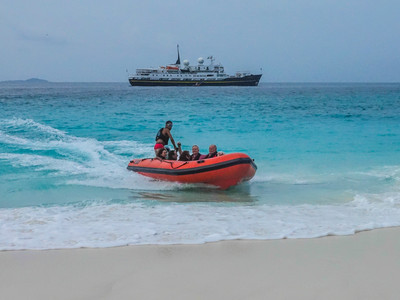
Sunday, 10th December 2017 - Desroches, Amirantes group, Seychelles
At 7 am we are anchored offshore Desroches Island in the Amirantes Group and at 9 am we go ashore at Bombay Beach. It seems the bay is aptly named, as most people we meet ashore are Indian workers who were brought in to build a hotel and cottages. We have to walk for about half a kilometre to see the tortoise pen, where endangered Aldabra tortoises are raised. It was installed in 2007 by the island conservation society. On the way we observe an Amur falcon, a vagrant to the granitic islands and Amirantes. Another few hundred meters further we arrive at the small settlement. Copra production was the main occupation of the people of Desroches, but today only very few inhabitants still carry on with the trade. Bombay Beach is also a nice swimming spot and a safe location to try out our snorkel gear. At 12:15 pm the last Zodiac returns to the ship and we are looking forward to our BBQ lunch on the outer decks. After the sumptuous lunch we need some time to digest, but at 2:30 pm our Zodiacs are ready again to take us out to the beach or to a snorkelling platform. The falling tide causes quite some big swells near the snorkelling platform and it is a challenge to climb the ladder back into the zodiac. Nevertheless, we spot some colourful fish and a stingray. Life on the beach is much more quiet and quite a few of us take the opportunity for a leisurely bath in the lukewarm water. Around 5 pm everybody has soaked up enough sun and the last Zodiac heads back to the ship. At 6:45 pm we meet again in the Andrea Lounge for a recap and briefing and at 9 pm Chris invites everybody for the ultimate Indian Ocean Quiz Night.
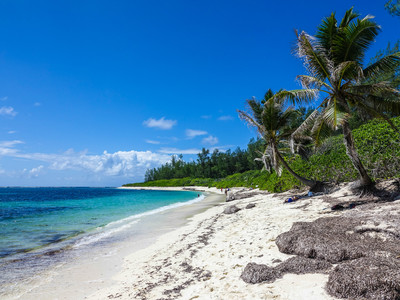
Monday, 11th December 2017 - Alphonse Island, Alphonse Group, Seychelles
At 7 am we anchor outside the lagoon of Alphonse Island. The weather is beautiful, blue sky and just a few clouds. We have a long run in with the Zodiacs today, just under 4 nautical miles. First we skirt along the outer reef until we spot a large yellow buoy, which marks the entrance to the channel leading into the vast lagoon. Within the lagoon more buoys guide us to the landing beach. Alphonse Island has a landing strip for small planes, which bisects the island. One half of the island is taken up by a small resort, but we can walk on the other half. We stroll through the abandoned coconut and cotton plantation, which is slowly taken over by native vegetation. On the way we spot green day geckos, palm and crab spiders, fairy terns and white-tailed tropicbirds soaring above. A green-backed heron watches us from the safety of a palm tree. Near a breeding colony of shearwaters we encounter a small flock of common waxbills. They have been introduced like the house sparrows we see near the hotel. In spite of having rats on the island the shearwaters still try to breed here, assisted by measures taken by IDC. Back at the beach we don our snorkel gear and check out the underwater fauna on the little house reef. We see some colourful reef fish as well as some giant trevallies. Around 11:30 am the Zodiac shuttle back to the ship commences and at 12:30 we are all back on board for lunch. In the afternoon we continue to sail south and at 2:30 pm our SOLACE security guard Chris Lockie presents an "Overview of the piracy in the Indian Ocean". At 5:15 pm Jean-Pierre prepares us for the landing and snorkelling operation tomorrow and at 5:30 pm Franz gives a presentation on the geology of the Indian Ocean islands in his talk "Seychelles, Madagascar and Mauritius - lost islands of Gondwana".
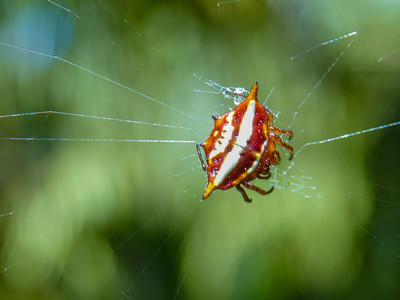
Tuesday, 12th December 2017 - Providence Island, Farquhar Islands, Seychelles
We have a choice of activities again this morning. There is an opportunity to drift-snorkel along the reef from one platform to another. There is not too much coral, but plenty of reef fish to see. The high tide also enables us to cross the shallow lagoon and land on Providence Island. We are greeted by a committee of horseflies, who are only to happy to see us. It gets better a short distance inland, where we can see the remains of the settlement on Providence Island. Fishing and copra production was the livelihood of the few inhabitants, but cyclone Bondo destroyed the settlement as well as many of the coconut trees in 2006. Around noon we wrap up the operation and everybody is back for lunch at 12:30. We spend the afternoon at sea and therefore have time to relax or attend the lectures offered. At 3 pm Conrad presents the "Fish of the Indian Ocean" and at 5 pm our indigenous Seychellois Guy continues with a presentation about "Managing and protecting Aldabra World Heritage Site". Anchorage is off Providence Island.
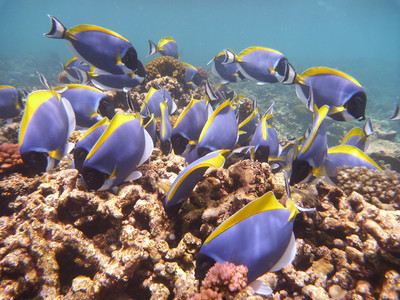
Wednesday, 13th December 2017 - Cosmoledo, Aldabra Islands, Seychelles
Today we plan to visit the large atoll of Cosmoledo, 110 km east of Aldabra. It is uninhabited since 1992 and 13 raised coral islands form a ring around a shallow lagoon. The atoll boasts a high biodiversity and the islands are important breeding grounds for a large number of seabirds. Ile de Sud-Ouest holds the largest red-footed booby colony in the Indian Ocean with 15,000 to 20,000 breeding pairs. Brown boobies and masked boobies are found as well. Red-tailed tropicbirds and fairy terns breed in low numbers and both species of frigatebirds are frequent visitors. At 9 am the tide is high enough that we can Zodiac cruise in the lagoon and all 8 Zodiacs enter through the "Grande Passe" channel. We give the shallows near the island a wide berth and approach "Ile de Sud-Ouest" from the back side. Landing on the sandy beach is easy and we have an hour to explore the island. The red-footed boobies (Sula sula) are most conspicuous as they nest in the trees. We also spot ground-nesting masked boobies (Sula dactylatra) and a few brown boobies (Sula leucogaster). Deep in the undergrowth we discover the nest of a red-tailed tropicbird (Phaeton rubricauda). "Ile de Sud-Ouest is also home to the Abbott's sunbird (Cynniris abbotti) and a particular form of Aldabra turtle dove (Nesoenas coppingeri). The Madagascar cisticola (Cisticola cherina) is also common and we discover a few juvenile grey herons as well as some dimorphic egrets. In our second landing beach we are greeted by a flock of black-naped terns (Sterna sumatrana). As dark threatening rainclouds are getting closer and closer we leave the island and exit the lagoon through the "Passe Sud-Oueste" to meet our ship, which has repositioned in the meantime. We just beat the rain and at 12:30 everybody is back on board. The showers continue well into the afternoon and the associated wind and swell make the intended landing on Menai Island impossible. So Guy gives a talk on the Aldabra tortoise at 3:30 pm and at 4:30 pm the sun is back. Quickly we establish a snorkel platform and enjoy a snorkel along the outer reef until 5:45 pm. At 6:45 pm we meet in the Andrea Lounge for our daily briefing and recap. Jean-Pierre gives us an overview on our 2 big days ahead on Aldabra and Dave summarizes the seabirds we have seen. Then it is time for dinner.
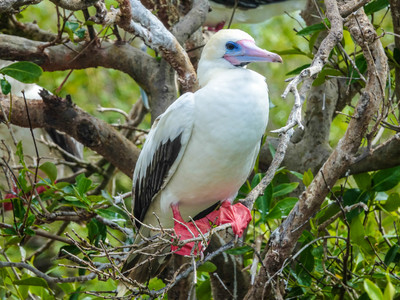
Thursday, 14th December 2017 - Aldabra, Seychelles
Finally we have reached one of the major attractions of this cruise, the famous atoll of Aldabra. It is a UNESCO world-heritage site and home to the Aldabra tortoise and some endemic birds. The spectacular underwater life is protected as well and this morning we plan to look at it. As usual everything here depends on the tides and during low tide the lagoon drains almost completely. We plan to drift-snorkel at West Channel on an incoming tide. But first we pick up the rangers in the morning, which turns out to be quite a wet enterprise! At 8:30 am they give us a briefing on Aldabra and soon after the boats head out to establish the snorkel platforms. For the ones who find the drift-snorkelling too challenging we offer a Zodiac cruise. The first of two rounds starts at 9:30 am and heads along the reef to look at the island and the occasional turtle, which pops its head up in the surf. We then head into West Channel as far as the tide allows and spot some brown noddies in the bushes. In the clear and still water we can also see stingrays, turtles and a variety of fish. It is almost as good as snorkelling, just without getting wet. The second round heads out at 10:30 am and pretty much follows the same route. In the meantime the snorkellers are out in the channel and with all the people in the water and the boats about it looks very busy. The water is very clear and we spot and amazing variety of fish. By noon we are all back on board to enjoy an early lunch. The noon break is very short as we have to make the most of the tides. The big surf makes it impossible to land near the scientific station, so we need to use West Pass and the lagoon to reach Picard Station on West Island. The lagoon is very shallow and the high tide gives us a 2-3 hour window. First we bring the "Long Hikers" ashore, who enjoy walking for 1-2 hours.Then everybody else follows for the shorter walks. The local rangers guide us through the bush and then to the old settlement. It has some abandoned houses and a small church. From there we walk back along the beach to the scientific station. On the way we encounter quite a few giant Aldabra tortoises, who sensibly keep in the shade. The birds keep quiet in the midday heat, but closer to the station the birdlife increases. We spot a Seychelles kestrel, a pair of Amur falcons, Souimanga sunbirds (Cinnyris souimanga), pied crows (Corvus albus), the Aldabra turtle dove (Nesoenas coppingeri), the Comoro blue pigeon (Alectroaenas sganzini), the Aldabra fody (Foudia aldabrana), the Aldabra drongo (Dicrurus aldabranus) and the Madagascar white-eye (Zosterops maderaspatanus). Very briefly we also get a glimpse of a pair of the elusive Aldabra rail (Dryolimnas aldabranus). Near the little church we find one Aldabra flying fox feeding in a tree. There is just enough time to buy a few souvenirs in the little station shop and then we have to rush back to the landing site and jump into the Zodiacs. We are losing the water in the lagoon rapidly and we do not want to spend the night on the island. By 5:30 pm everybody is back on board and we have our well-deserved cocktails, followed by a BBQ dinner on the outer decks.
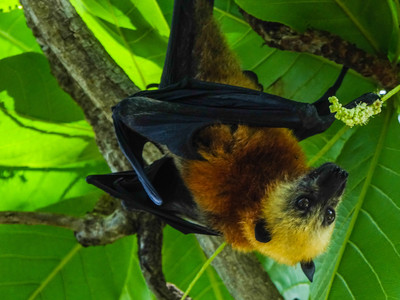
Friday, 15th December 2017 - Aldabra, Seychelles
It is low tide again in the morning so we snorkel off a platform in front of the reef. Around 9:30 am the first snorkelers head out to investigate the underwater world. There is quite some surf and the visibility is not too good, but there are still a lot of fish to see. The highlight is a big manta ray, which keeps popping up from time to time. At 11 am the conditions worsen so we decide to head back to the ship. After a leisurely lunch, at 3 pm the tide is high enough and we enter the vast Aldabra lagoon through the main channel in the north. It is quite choppy in the channel, but calm in the lagoon. The first spot is a chick of a tropicbird sitting in a hole in one of the isolated mushroom-shaped rocks. We slowly cruise along the mangrove-covered shores, which are interspersed with sandy beaches. On one of the beaches we find a flock of swift terns (Thalasseus bergii). They are large terns with a crest and a characteristic yellow bill. Close by are the tracks of a massive turtle, which must have come ashore to lay its eggs. The next find is a pair of Madagascar coucals (Centropus toulou), which are very vocal and permanently call to each other. The highlight of the lagoon is of course the large colony of frigatebirds nesting in the mangroves together with a few red-footed boobies. Lesser frigatebirds (Fregata ariel) and Greater frigatebirds (Fregata minor) nest together. The male Lesser frigatebird is only distinguishable from the Greater frigatebird in flight by its white "armpits". A female Souimanga sunbird has taken residence just under a frigatebird nest and is busily building its own home. We also pass by a nest of the dimorphic egret (Egretta dimorpha), which is well hidden in the mangroves. Now and again a turtle pops its head up and some boats get glimpses of various sharks. Just before we reach West Pass a group of four stingrays bids us farewell from Aldabra Lagoon. We drop our rangers at the station and head our ship which has repositioned and is waiting for us just offshore the scientific station. At 7 pm we have our daily recap and briefing for tomorrow. Jean-Pierre is explaining our plans for Assumption Island and Conrad shows his clips of the underwater world he has taken on this trip.
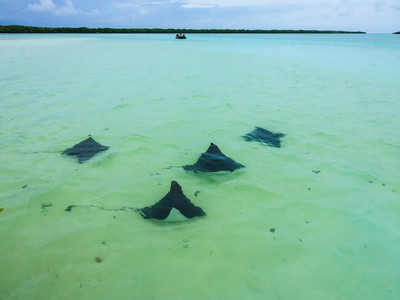
Saturday, 16th December 2017 - Assumption, Aldabra Islands, Seychelles
Today we have to clear out of the Seychelles and Assumption Island is the place to do it. It has a long airstrip, built by the Russians in the late 1970s, when the Seychelles government had close ties with communist countries. Assumption also acts as a hub for everybody who wants to visit Aldabra. It is a 3-hour flight from Mahe and a 2-3- hour boat ride to Aldabra. Assumption Island used to have one of the largest guano deposits in the Indian Ocean. The deposits were up to 50 m thick and were mined until 1983. Most of the guano was shipped as fertilizer to Sweden and some to Mauritius. Stripped of vegetation and guano the island was left with just bar rock and sand. Now vegetation is coming back slowly and some of the guano is shipped back to Assumption to boost the recovery. The sky is overcast with an occasional sprinkle of rain as we start our nature walks on the island this morning. Perfect conditions for a walk as there is not much shade. Once we reach the runway we find quite a few Aldabra tortoises on and near the airstrip enjoying the open, grassy area. We also spot a few Abbott's sunbirds and a green-backed heron. On the way back we also visit the little settlement and the cemetery. Assumption has a fantastic beach with fine sand and the surf is not too strong this morning. We are able to swim out to our snorkel platforms, which have been established on the reef. The water is quite clear and this is our last chance to enjoy the colourful fish and coral of the Indian Ocean. At noon the last Zodiac heads back to the ship and while the officials on board clear us out of the Seychelles we enjoy another one of those fabulous lunches. In the afternoon we start sailing towards Africa and there is time for a long lunch break and lectures. At 3:30 pm Guy talks about "Aldabra in the old days" and at 5 pm Franz presents "Reefs, past and present". After dinner our pianist Vasily gives a classical concert in the Andrea Lounge.
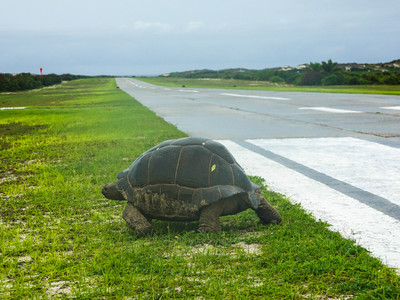
Sunday, 17th December 2017 - At Sea, en route to Zanzibar, Tanzania
Today is reserved for activities we had no time for so far. The day starts with tours of the engine room followed by a demonstration in fruit carving by our master carver Jaycee. At 11 am Conrad presents the "Plants of the Indian Ocean" and early in the afternoon there is time for more engine room tours. At 3 pm we have a short presentation by Chris, who talks about his "Life in the Royal Marines". At 5 pm Jean-Pierre gives us a briefing on the planned activities in Zanzibar and the inevitable disembarkation in Dar es Salaam. Afterward Neil explains "Why the Indian Ocean is so unusual". At 7 pm Captain Lukša Lale has the pleasure of inviting us all to the Captain's Farewell Cocktail Party in the Andrea Lounge.
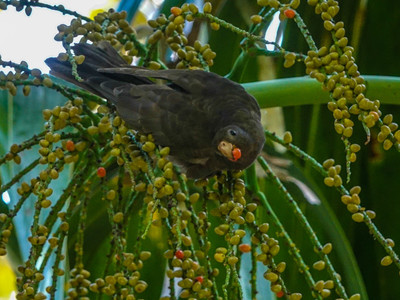
Monday, 18th December 2017 - Zanzibar, Tanzania
At 7 am we dock in Stonetown on the spice island of Zanzibar. Today is the first day since we left Mahe that we can walk off the ship on a gangway. After the ship is cleared into Tanzania we are free to hop on our minibuses and start the tour of historic Stonetown. We visit the Sultan's Palace, the Old Fort and walk along scenic Gizenga Street to end at the old post office. Finally we visit the Anglican Cathedral and the Slave Market, before we head back to our ship. There is also some free time to shop for souvenirs and for refreshments at the Serena Inn. We are all back for lunch on the MS Serenissima and in the afternoon we have free time or a choice of one of two tours. The "Spice Tour" starts with a short 40-minute drive to the spice plantation, where we see various spice plants and fruit trees. It is a leisurely countryside walk through the plantation with detailed explanations of the various plants. The second option is more for those interested in the "wild side" of Zanzibar. After a 45-minute drive we reach the Jozani Forest, home to a variety of birdlife and the famous endemic "Red Colobus Monkey". It takes a while to find the monkeys in the forest, but finally we spot an extended family. There are two mothers with babies and several males, quietly feeding in the trees. They are not really shy, but there always seems to be leaves or branches between us and them, preventing a decent photo. They also refuse to look at us, while chewing on their leaves, but finally we have their attention and manage to get a shot of the day. For good measure we also visit the nearby boardwalk through the mangroves and with a lot less traffic we are back on board by 6 pm. After dinner we enjoy Dave's slideshow of the trip, which reminds us of all the fantastic sights we had on this voyage.
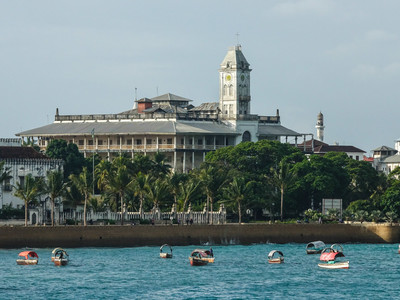
Tuesday, 19th December 2017 - Dar es Salaam, Tanzania
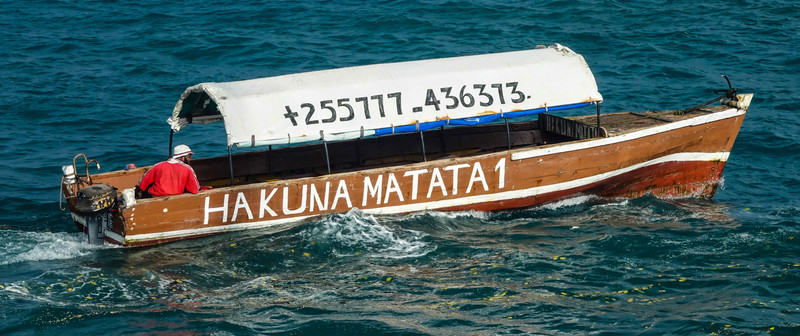
In the morning we dock in Dar es Salaam, the main port city of Tansania. It has been an interesting cruise, hopping along the islands of the Seychelles. We board our buses and head to the Serena Hotel, where we will have a day room until our buses will bring us to the airport. At 4:30 pm we will fly home to England and will certainly miss the weather in the Indian Ocean. The memories of this exciting trip will stay with us and hopefully we'll meet again on our MS Serenissima or on another ship of the Noble Caledonia fleet.
End of Voyage
For further inspiration, view slideshow of images taken during the voyage






